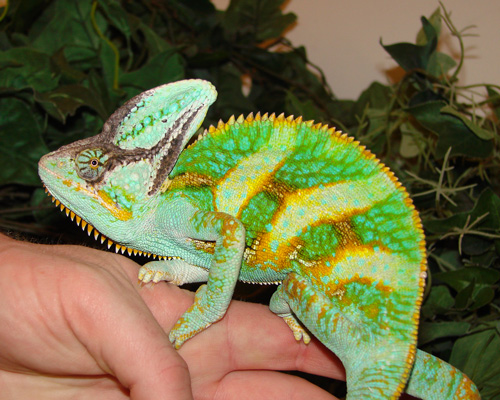Tips on keeping your chameleons healthy.
Research the Species You Plan to Keep
Research each individual species in your care. Although most chameleons have similar lifestyles, different species inhabit diverse environments. Factors such as climate and diet, for example, of the and the sailfin chameleon. C. [Trioceros] montium are very dissimilar. Learning all you can about the proper husbandry of each species of chameleon you keep is the greatest contribution you can make to your pet’s health. Investigate your chameleon’s exact needs, contact experts in its care and consult a qualified reptile veterinarian.

Photo courtesy Denise Orleans.
Select captive-bred chameleons. They tend to be healthier.
Minimize Stress
Chameleons fare best with minimal disturbance and little or no handling. Their habitats should be placed in a quiet location and plenty of cover should be provided in their cage. Except for breeding purposes or rearing a number of young, chameleons are best housed alone.
House in a Spacious, Well-Ventilated, Planted Cage
The best indoor chameleon habitat is a cage constructed entirely from screen. These cages provide essential airflow. Choose the largest cage you can based on the maximum adult size of your species, and provide plenty of perches and cover, such as Schefflera spp. or Ficus spp. plants.
Provide UVA/UVB Exposure
Basking lizards benefit greatly from the sun’s rays, and chameleons housed indoors require special lighting that provides sufficient UVA and UVB (5.0-plus) for both physical and psychological health. Replace fluorescent UVB reptile lamps periodically as per manufacturer’s recommendation to ensure maximum output and ensure that the bulbs come within 12 inches of your chameleon’s favored perching and basking spot. Mercury vapor ultraviolet basking lamps are only appropriate for a sun-loving species like the veiled chameleon, and should not be used for most chameleons.
Provide an Appropriate Basking Spot
Position a branch or other perch beneath an incandescent lamp so that a hotspot is created at the upper end of the species’ optimal temperature range. Neighboring perches should allow the chameleon to move closer or farther as it chooses to adjust body temperature (thermoregulate).
Keep Hydrated
Few chameleons will drink from a water dish, and habitat misting and/or drip systems are essential for providing clean drinking water to maintain hydration.
Maximize Nutrition
Feeder insects should be offered a healthy diet including fresh vegetables and clean water for at least 24 hours prior to offering them to your chameleons. Food should be dusted periodically with a quality reptile mineral and vitamin supplement containing D3, but remember that calcium and vitamin needs vary with species and chameleon age. Avoid over supplementation. A healthy, varied diet is your chameleon’s best source of nutrition. In addition to crickets, which may be offered as the primary insect prey, silkworms, hornworms, superworms and roaches are popular additional choices that contribute to a healthy, varied chameleon diet. Some species, including veiled chameleons, also eat some plant matter, and greens (e.g., turnip, mustard) should be offered once a week.
Avoid Skin-Shedding Problems
Careful attention should be paid during shedding. Cage humidity, usually provided by warm-water misting, may need to be increased for several days to facilitate the process. Occasionally, it may become necessary to remove stubborn pieces of old skin, especially from the feet and end of the tail, to prevent constriction of circulation and resultant health problems.
Avoid Early Breeding
Captive female chameleons may reach sexual maturity before they have sufficient size and weight for healthy reproduction. Females older than a few months should not be housed with a male until they are about one year of age.


